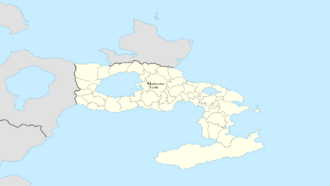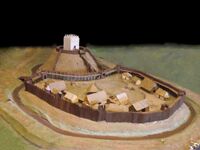Ledecester Castle
| Ledecester Castle | |
|---|---|
| Ledecester in Angland | |
 Ledecester Castle located along the River Vesin | |
 Map of Ledecester Castle in Angland | |
| Site information | |
| Owner | King Edward Foundation |
| Operator | Henriad Entertainments |
| Open to the public | 1959 |
| Condition | Maintained |
| Site history | |
| Built | 1056 |
| Built by | Anglo-Herulians (originally) House Orange (reconstruction) |
| Materials | Stone |
Ledecester Castle is a medieval castle and fortress in Ledecestershire, Middle-Angland. Originally constructed by Stephen the Great as a wooden fort to secure his lands to the north, against Brynnish forces, the original wooden motte-and-bailey was rebuilt by Henry II with stone in the 12th century after being burned during the Bodiam Wars. It was known that the castle came under personal posession of Edward I due to his marriage to the Lady of Ledecester, and he spent much of his late life within the walls. During the Endless War the castle was refortified along with the surrounding town of Ledecester with the grant of Robert Priestley, 6th Count of Ledecester. It remained as a shining example of 14th century military architecture and a stronghold until it was granted to Sir Falk Priestley in 1601. Falk Priestley converted the castle into a country house, where it became the ancestral home of the Priestley Family up until it's purchase in 1953 by Henriad Entertainments and the King Edward Foundation.
The site is maintained by the King Edward Foundation, acting under Henriad Entertainments, and the castle now offers leisure gardens, bird shows and medieval battle recreations.
History
Original Site and Construction
Built originally as a wooden motte-and-bailey under the direct instruction of King Stephen during his conquest of the Anglican Peninsula as he looked to maintain Middle-Angland on his conquest further south. It was governed initially by one of his chief advisors, Francis of dey Arromannc, who was an early ancestor of the Priestley family. On the land the castle was built already existed an early predecessor settlement to Ledecester, in which at least 18 homes were destroyed to make way for the construction of the castle in an advantageous position. A traditional motte-and-bailey style caste features a keep atop a mound, an enclosed courtyard known as a bailey (hence motte and bailey) however the exact layout of Ledecester's fort is unkown. In 1099, Henry, member of the family of dey Arromannc, was made the first Count of Ledecester. It was under Henry that the castle's Church of All Faiths was established.
The original east wall of the motte-and-bailey was burned to at least half of it's original size during a dispute between the 3rd Count of Ledecester and the 1st Count of Leamings, which lead to it being replaced with a singular ancient stone wall that stands older than all other reformed walls.
Rebuilding and Middle-Ages
During the reign of Henry II (1154-69), the wooden motte-and-bailey was finally replaced with a more fitting stone keep castle to maintain the stability of Middle-Angland and Ledecester. The new building phase took a total of 10 years to complete. In the Lord's Revolt of 1173 the Earl of Ledecester stayed loyal to Henry, which was later rewarded.
